
A heritage railway or heritage railroad is a railway operated as living history to recreate or preserve railway scenes of the past. Heritage railways are often old railway lines preserved in a state depicting a period in the history of rail transport.

Talgo is a Spanish manufacturer of intercity, standard, and high-speed passenger trains. Talgo is an abbreviation of Tren Articulado Ligero Goicoechea Oriol

In railroad terminology, a stock car or cattle car is a type of rolling stock used for carrying livestock to market. A traditional stock car resembles a boxcar with louvered instead of solid car sides for the purpose of providing ventilation; stock cars can be single-level for large animals such as cattle or horses, or they can have two or three levels for smaller animals such as sheep, pigs, and poultry. Specialized types of stock cars have been built to haul live fish and shellfish and circus animals such as camels and elephants. Until the 1880s, when the Mather Stock Car Company and others introduced "more humane" stock cars, death rates could be quite high as the animals were hauled over long distances. Improved technology and faster shipping times have greatly reduced deaths.

The Louisville and Nashville Railroad, commonly called the L&N, was a Class I railroad that operated freight and passenger services in the southeast United States.

The Railroad Museum of Pennsylvania is a railroad museum in Strasburg, Lancaster County, Pennsylvania.

The Central of Georgia Railway started as the Central Rail Road and Canal Company in 1833. As a way to better attract investment capital, the railroad changed its name to Central Rail Road and Banking Company of Georgia. This railroad was constructed to join the Macon and Western Railroad at Macon, Georgia, in the United States, and run to Savannah. This created a rail link from Chattanooga, on the Tennessee River, to seaports on the Atlantic Ocean. It took from 1837 to 1843 to build the railroad from Savannah to the eastern bank of the Ocmulgee River at Macon; a bridge into the city was not built until 1851.

The Fort Smith Trolley Museum is a streetcar and railroad museum in Fort Smith, in the U.S. state of Arkansas, which includes an operating heritage streetcar line. The museum opened in 1985, and operation of its streetcar line began in 1991. Four vehicles in its collection, a streetcar and three steam locomotives, are listed on the National Register of Historic Places (NRHP). The now approximately three-quarters-mile-long (1.2 km) streetcar line also passes four NRHP-listed sites, including the Fort Smith National Historic Site, the Fort Smith National Cemetery, the West Garrison Avenue Historic District and the 1907 Atkinson-Williams Warehouse Building, which now houses the Fort Smith Museum of History.
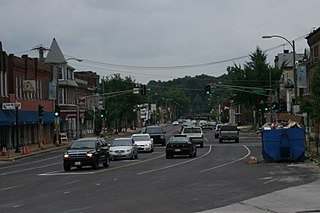
Baden is a neighborhood of St. Louis, Missouri.
The Michigan-Peninsular Car Company was a railroad rolling stock manufacturing company formed from the merger of five manufacturing companies in 1892. It was Detroit's largest manufacturer before the rise of the automotive industry.
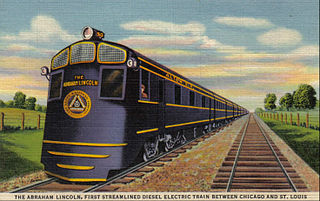
The Abraham Lincoln was a named passenger train operated by the Baltimore and Ohio Railroad from 1935 into the 1960s. The Abe Lincoln ran between Chicago and St. Louis on the B&O's subsidiary Alton Railroad. The train later passed to the Gulf, Mobile and Ohio Railroad, and then finally to Amtrak, which retained the name until 1978. Service between Chicago and St. Louis is now known by the umbrella term Lincoln Service. This train was the first streamlined passenger service to travel the 284 miles between Chicago and St. Louis, with Joliet, Bloomington-Normal, Springfield and Alton in between. Passengers can get a glimpse of the Mississippi River between Alton and St. Louis.
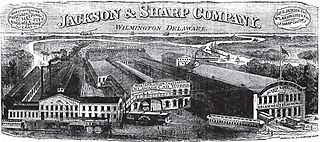
Jackson and Sharp Company was an American railroad car manufacturer and shipbuilder in the late 19th and early 20th centuries. The company was founded in 1863 by Job H. Jackson, a tinsmith and retail merchant, and Jacob F. Sharp, a carpenter who had worked for rail car manufacturers and shipbuilders.
The railcar couplers or couplings listed, described, and depicted below are used worldwide on legacy and modern railways. Compatible and similar designs are frequently referred to using widely differing make, brand, regional or nick names, which can make describing standard or typical designs confusing. Dimensions and ratings noted in these articles are usually of nominal or typical components and systems, though standards and practices also vary widely with railway, region, and era. Transition between incompatible coupler types may be accomplished using dual couplings, a coupling adapter or a barrier wagon.
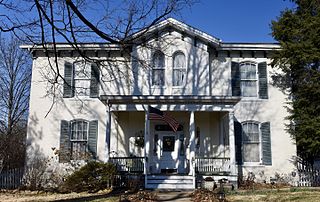
Frenchtown Historic District is a national historic district located at St. Charles, St. Charles County, Missouri. The district encompasses 205 contributing buildings and 1 contributing structure in the Frenchtown section of St. Charles. It developed between about 1830 and 1940, and includes representative examples of Greek Revival style, Late Victorian style and Colonial style architecture. The district includes an industrial complex associated with the St. Charles Car Company, founded in 1873, and later known as the American Car and Foundry Company.

The St. Charles Odd Fellows Hall is historic Odd Fellows hall located at St. Charles, St. Charles County, Missouri. It is a 3 1/2-story, brick Second Empire-styled building that was built in 1878. A small two-story rear addition was constructed about 1900. It served historically as a clubhouse, as an auditorium, and as a financial institution.

The Wabash Railroad was a Class I railroad that operated in the mid-central United States. It served a large area, including track in the states of Ohio, Indiana, Illinois, Iowa, Michigan, and Missouri and the province of Ontario. Its primary connections included Chicago, Illinois; Kansas City, Missouri; Detroit, Michigan; Buffalo, New York; St. Louis, Missouri; and Toledo, Ohio.
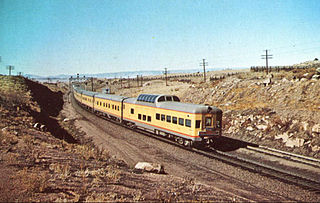
The Astra Domes were a fleet of streamlined dome cars built by the American Car and Foundry Company ("ACF") and later by Pullman-Standard ("PS") for the Union Pacific Railroad between 1954–1958. ACF built a total of 35 cars including coaches, dining cars, and observation cars, while PS built 5 for Union Pacific. After Union Pacific exited the passenger business in 1971 the Auto-Train Corporation purchased most of the fleet and operated them for an additional ten years.
















